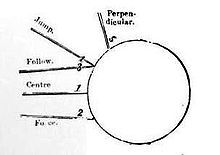Our website is made possible by displaying online advertisements to our visitors.
Please consider supporting us by disabling your ad blocker.
Cue sports techniques
This article needs additional citations for verification. (February 2012) |

Cue sports techniques (usually more specific, e.g., billiards techniques, snooker techniques) are a vital important aspect of game play in the various cue sports such as carom billiards, pool, snooker and other games. Such techniques are used on each shot in an attempt to achieve an immediate aim such as scoring or playing a safety, while at the same time exercising control over the positioning of the cue ball and often the object balls for the next shot or inning.
In carom games, an advanced player's aim on most shots is to leave the cue ball and the object balls in position so that the next shot is of a less difficult variety to make the requisite carom, and so that the next shot is in position to be manipulated in turn for yet another shot, ad infinitum.
Similarly, in many pocket billiards games, an advanced player's aim is to manipulate the cue ball so that it is in position to pocket (pot) a chosen next object ball, and so that the next shot can also be manipulated for the next shot, and so on. Whereas in the carom games, manipulation of the object ball's position is crucial as well on every shot, in some pool games this is not as large a factor because on a successful shot the object ball is pocketed. However, many shots in one-pocket, for example, have this same added object ball control factor for most shots.
If a player is not attempting to score or pocket, depending on the game, then the goal is usually to exercise control over the cue ball to leave some type of safety to make it more difficult for the opponent to score or pocket.
In order to control the cue ball on a shot, a player must master a wide variety of techniques, and have a well-founded conceptual grasp of the mechanics involved. As stated by George Fels, "pool's poet laureate":[1]
The mere pocketing of a ball isn't that hard; in fact, it's relatively simple. What drives many, many players to distraction is the unpredictability of the cueball's path of travel .... [T]he game of billiards requires you to drive a ball someplace; pool, in any form, mostly asks you to stop a ball someplace. In either case, you'll fare much better when you understand the how and why of a ball's getting from one place to another.
- ^ Fels, George. Quoted in: Fels, George (1991). "Introduction". In Harris, Walt (ed.). The Billiard Atlas on Systems & Techniques. Vol. 1. Cocoa Beach, Florida: Billiard Atlas. p. xvii. ISBN 0-9631204-0-9.
Previous Page Next Page


